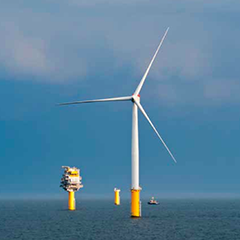Operations and Maintenance is expected to account for nearly one-third of offshore wind’s costs in the United States, and consequently, there is a large potential for reducing these through advanced O&M strategies. NREL and ECN, along with a panel of subject matter experts who provided input, have proposed a few suggestions…
The following O&M strategies are common within offshore wind the world over:
• Mother vessel accommodation
• Helicopter access
• O&M vessel contracts
• Improved crew transfer system
• Spare part storage
• Advanced CBM.
Our analysis investigated how each of the proposed strategies affects downtime and O&M costs relative to the baseline O&M strategy. In the following subsections we present our findings, including a qualitative analysis of possible limitations for each of the alternative O&M strategies as well as a summary of the qualitative results.
Mother vessel accommodations
Mother vessel accommodation has the benefit of significantly reducing the time to access the wind plant for minor repairs or inspection, with respect to operating out of port. Additionally, because of the reduced travel times, the fair weather windows are smaller, thus allowing for more weather window opportunities that also reduce wind plant downtime. There are also disadvantages; both costs of vessels and worker wages are higher with the use of offshore accommodations.
For the baseline scenario, we assume that maintenance is organized from the Port of Virginia at an approximate distance of 86 km from the wind plant. This results in a one-way travel time of 2.6h. In this subsection we discuss whether organizing the maintenance from an offshore base (e.g., a mother vessel) is beneficial for this location.
The mother vessel accommodations scenario differs from the baseline scenario in two ways. First, corrective and preventive maintenance will be performed from a mother vessel located inside or close to the wind plant. From this mother vessel, workboats can be launched with an average travel time of 0.5 h, including the transfer of personnel to the turbine. Second, small parts (up to 2,000 kg) will be kept in stock at the mother vessel instead of the harbor. Very little information is available on the costs for such a mother vessel in the United States.
As a result, we chose not to include an estimated mother vessel cost to avoid false or misleading results. Instead, we consider only the benefits associated with this strategy. When more information on the investment and operational costs for a mother vessel become available the results of this analysis can be used to assess whether the use of a mother vessel would be an economically prudent solution. Organizing the maintenance from a mother vessel results in a significantly improved availability, compared to the baseline scenario, in which workboats are launched from shore.



























